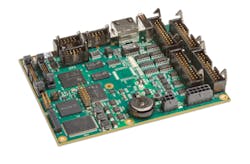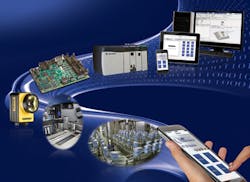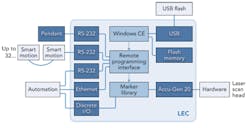Laser marking joins the Industrial Internet of Things
Automation of many manual tasks now possible
CHRIS OSKIRKO
In 1964, companies such as GM, Westinghouse, and IBM showcased the future of computers and their role in manufacturing and communications at the World's Fair in Queens, NY. IBM, for example, demonstrated handwriting recognition using its mainframe computer. Visitors could write down a date and the computer would then look up what happened on that date. At the Bell System Pavilion, visitors could place phone calls using the Picturephone—a system comprised of a landline phone and video monitor. Visitors could also call the sister exhibit at Disneyland in California. It turns out people didn't like the Picturephone, as the system was deemed too bulky, not user-friendly, and too intrusive!
Technology—and how we use it—has definitely changed in 50 years. Thanks to the Internet, we can connect to our friends and to our devices. Today's "smart" or Internet-enabled devices allow us to reach a colleague halfway around the world or program our thermostats, even when we're not at home!
This connectivity—between our smart devices and the Internet—is what's referred to as the "Internet of Things." But smart devices aren't limited to consumer goods: manufacturers have also become "smart" in that recent innovations allow devices, machines, and equipment to communicate seamlessly with each other in an automated factory network.
The Industrial Internet of Things (IIoT), a term coined by Richard Nass of Automation World, is transforming how manufacturers do business. A $14 trillion industry—with manufacturing representing 27 percent of the pie, according to Manufacturing.net—the IIoT is comprised of hardware and software, tools, systems integration, the factory network, and the cloud. And it's enabling manufacturers to do things they only dreamed about even five years ago.
Laser marking becomes 'smart'
Due to technology advancements, the IIoT allows manufacturers to automate many of the tasks they used to perform manually. Multiple devices and machines on the factory network can handle inputs and outputs from the programmable logic controller (PLC), such as automatically starting and stopping production sequences based on pre-determined parameters. The IIoT gives manufacturers central control over all the machines and devices in the factory, including Lanmark Controls' new "smart" LEC laser marking control boards (FIGURE 1).
With their ability to connect to the factory network and communicate with the PLC, these new "smart" boards allow integrators to create laser marking systems that meet the challenges facing manufacturers today: managing multiple jobs or automation lines simultaneously and remotely while increasing efficiencies and reducing wasted movements and space.
Before the smart boards were developed, large manufacturers, such as one in Korea, would have multiple PCs—each one dedicated to a laser marking machine. To change a job, the factory engineer would go to each machine and manually upload the new job-a time-consuming and inefficient process. With today's new laser marking control boards, this same manufacturer now has one PLC managing multiple LEC boards. To change a job, the engineer makes the change at the PLC—and the change is transmitted through to all the machines on the network. Smart!
Also, if a factory manager connects a smart laser marking control board from the factory network to the Internet, this connection opens new possibilities for system maintenance, monitoring, operation, remote troubleshooting, and product support. For example, users could choose to have devices automatically upgraded, or they could allow customers or developers around the globe upload their laser marking designs to the system remotely.
How the LEC works
The LEC works similarly to an iPod. With an iPod, you download songs and can then select the song you want to play, shuffle the order of the songs, and pre-program playlists.
With the LEC laser marking controller, factory employees can pre-load laser marking jobs, which can be selected and programmed over the network. Factory engineers can dynamically interface with the board to change tracking and traceability information, such as the date, time, and shift, as well as interact with manufacturing database programs to change the information being marked.
What makes the board 'smart'
The advantage of the LEC, in the realm of the IIoT, is the multiple methods of access it gives manufacturers (FIGURE 2). One method is the ability to feed and retrieve information using the Application Programming Interface or Remote API. The pathway for the communication protocol, the Remote API allows the back-and-forth exchange of information between the LEC and the PLC, or the factory back-end database.
"Historically," says David Sweet, president of Mecco Marking & Traceability, "marking systems have not been able to communicate directly with a PLC. It's been a challenge for manufacturers who want to incorporate automated part marking into their processes. The Remote API—and its ability for bi-directional communication—is a key benefit for us. It has allowed us to do what we couldn't do before: seamlessly connect our clients' PLCs with their laser marking devices."
According to Sweet, Mecco developed EtherMark, an Ethernet IP communication solution to meet the needs of smart manufacturers, which effectively streamlines the communication to and automation of their laser marking systems into the IIoT.
"What this means," says Sweet, "is that a client can immediately load the PLC Add-On Profile that includes the object models (or command sets) they use the most, such as loading files, sending dynamic information, or applying x-y mark positions. They're able to go from nothing to programming to the LEC with their PLC within eight minutes, saving hours of programming time."
The built-in Remote API functionality also allows manufacturers to control the LEC using a computer, PLC, or other connected device. With this capability, integrators have the ability to create laser marking machines that allow factory engineers to access these machines remotely while also giving them the ability to manipulate and control data in a variety of ways, including TCP/IP, serial commands from a PC or PLC, or via a smartphone or tablet over the network.
The other big advantage is data. Because the Remote API allows for the back-and-forth exchange of information, the LEC is able to collect data, giving manufacturers the information needed to make crucial decisions, such as adding a second shift, determining why one production line is less efficient than another, or how many widgets were marked in a given time period.
The Remote API also allows for sophisticated laser marking functions: one manufacturer, for example, uses the Remote API in conjunction with a high-speed automation line to mark glass bottles. A camera verifies that the hot bottle, just out of the furnace, has passed inspection and then passes this information in a "yes/no" or "0/1" bit format to the LEC. If the bottle passes inspection, it's marked with an incremented serial number and 2D barcode; if it's rejected, it's marked with a rejection code. All of this happens in fractions of a second.
A 'node' on the network
Smart laser marking control boards connect to the factory network the same way that your printer connects to your home network-either through WiFi or an Ethernet connection (FIGURE 3). By controlling multiple laser marking control boards over the network, a manufacturer can simultaneously scribe, cut, and mark products or parts on multiple production lines, start or stop jobs in progress, change jobs, or even mark moving parts.
The LEC can also send notifications to factory managers when it detects that something is amiss on a machine. If the capability exists within the system, factory managers can identify the source of the problem and deal with it instantly—and remotely—using their smartphones or tablets. Operators and managers can view the status of and control machines using nothing more than the web browser that already exists on their device.
No PC required
With a smart laser control board, an integrator can build a laser marking system without an attendant PC; the system is then installed on the factory floor or production line and becomes part of the "smart" environment by simply "plugging" it into the network. Because the LEC is a "stand-alone" board, manufacturers are free from having to attach a PC. Now the board is a node on the smart network able to communicate over the API when needed-or stand silent until ready.
The high-performance LEC control board was developed because Lanmark Controls saw the demand for smart laser marking systems that worked seamlessly with the new automation systems being put in place by manufacturers. Real-time communication, the ability to analyze and use data, and interconnectivity within the factory environment are all key considerations for manufacturers today. Lanmark Control's new line of "smart" LEC control boards is the answer to these new demands.
ACKNOWLEDGEMENT
EtherMark is a trademark of Mecco Marking & Traceability.
CHRIS OSKIRKO([email protected]) is VP of Marketing and Sales for Lanmark Controls, Acton, MA.



